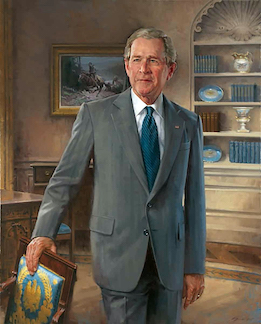George W. Bush Campaign Sign

This is a cardboard campaign sign featuring the George W. Bush presidential logo printed in white ink on a dark blue background. It was distributed early in the campaign and continued to be utilized throughout the 2000 presidential contest. The poster measures 22”x14”. It can be seen in campaign photos and videos at rallies and the Republican National Convention in Philadelphia.

Campaign posters have a long history in American politics. According to the University of Virginia’s Miller Center, John Quincy Adams was the first presidential candidate to widely use posters for a campaign, a tradition he began in 1824. The Library of Congress maintains a digital collection of historical political posters, but its earliest edition only dates back to the William Henry Harrison campaign of 1840.
Early campaign posters were more detailed than today’s designs. The printing was accomplished by using wooden or metal plates, which made it easier to reproduce text, but harder to create images. Photography wasn’t part of the process until the late 1800s. By the middle of the 20th century, posters began featuring black and white photos with color backgrounds and large text. As campaigns became more sophisticated, big block letters and slogans replaced the lengthy cursive script that was common in the 19th century. With advances in printing techniques, offset printing began and color photographs with full color layouts appeared around the time Richard Nixon assumed office.
Modern campaign posters have taken on a different purpose. While early placards delivered detailed information and illustrations, the goal now is simplicity. Today’s posters usually involve a block lettered rectangle with the candidate’s name and maybe a brief tagline. High level messaging and image creation is left to other forms of media. The poster is there just as a reminder, telling the voter who to vote for.





